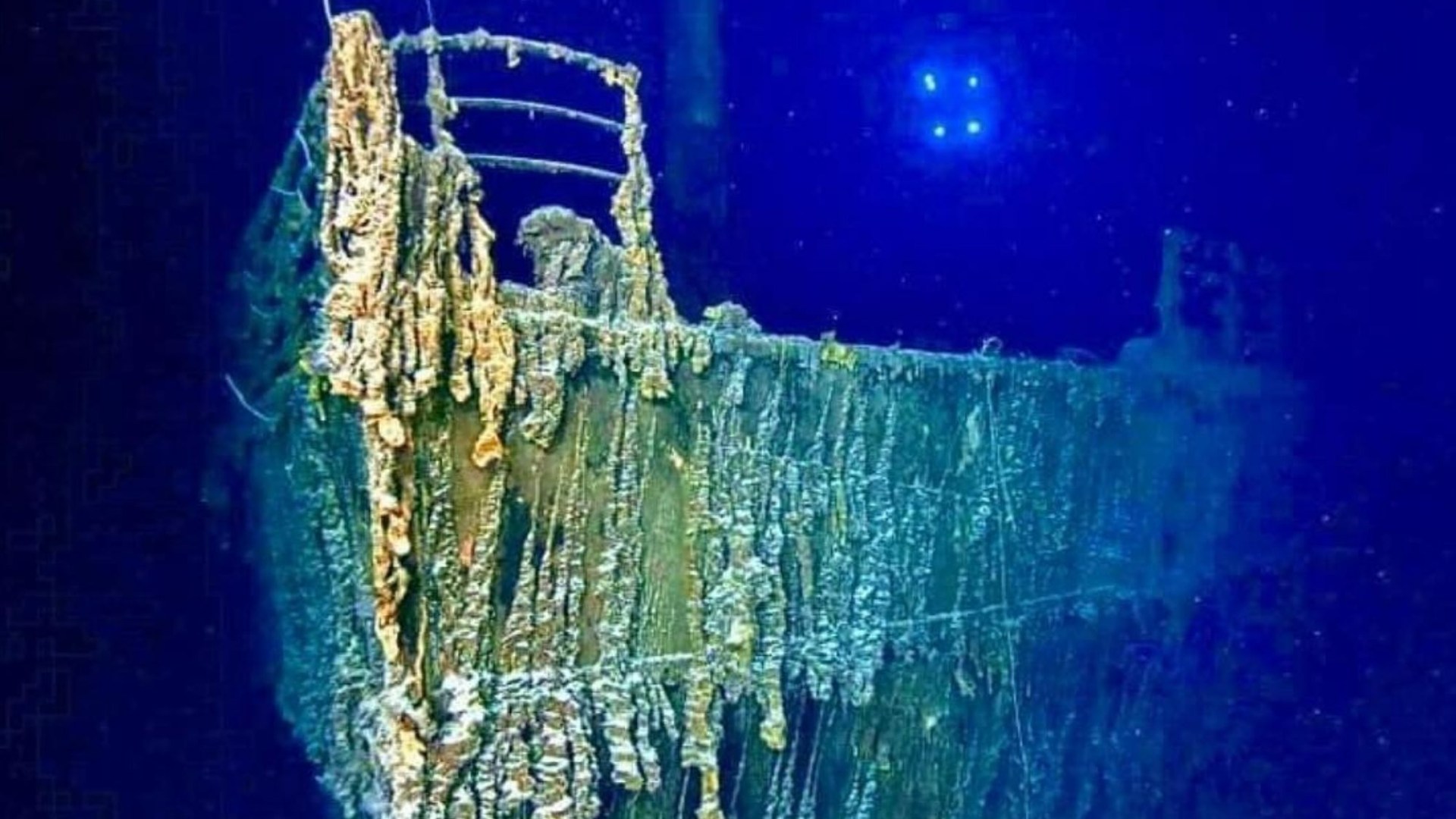THE LEGENDARY Titanic wreck could just be a pile of rust in just six years as new images show the vessel being “eaten” on the ocean floor.
A new expedition to the wreck discovered the ship is falling to pieces with large parts of the vessel now scattered on the seafloor.
13

13

13

13

13
The 112-year-old ruin is quickly decaying, with scientists revealing that the metal structure of the iconic ship is being eaten away by microbes – creating stalactites of rust called “rusticles”.
Experts have named the bacteria “Halomonas titanicae” – and they could consume the whole Titanic by 2030.
Images captured show how the wreck is continuing to change – and disintegrate – after more than a century on the seabed.
This summer RMS Titanic Inc explored the site and found that a large section of railing from the front of the ship now lays on the sea floor due to the hungry microbes.
Experts believe the nearly 15ft railing fell off at some point within the past two years as it was digitally scanned and photographed still intact in 2022 – showing the speed at which the wreck is decaying.
But using robot subs, the lost railing that is fondly remembered from the Titanic movie scene of Jack and Rose was found.
The ship’s interior continues to decay rapidly as passageways that were once accessible for subs have since collapsed.
Images taken of a bathtub from Captain Edward Smith’s quarters are clear to see in 1996.
But other pictures taken of the same bath in 2004 show how quickly the bacteria has attacked the interior to the point the room no longer exists.
Now this area can’t be seen at all as the incredible interiors have been tragically lost within the depths of the wreck.
Victor Vescovo, a Titanic expedition leader says it’s “biology and current” that are eroding the wreck – which is expected.
He told Time: “We should remember that the wreck has been down there 107 years in strong currents and seawater, so it is a matter of not if, but when, the sea will reclaim it in its entirety.”
There have been frequent calls since the wreck’s discovery in 1985 to bring the ship’s remains up to the surface.
This pressure grew after the release of the 1997 Titanic film.
But raising the vessel in the state it is in now would be a near-impossible task, experts claim.
It’s believed that if the ship were to be tampered with, much of what’s left of it would disintegrate.
This, partnered with some arguing that retrieving the ship would be unethical, leads us to believe the wreck will never meet the surface as a whole.
In 1998 RMS Titanic Inc, who own the salvage rights to the Titanic, managed to raise an unbelievable 20-tonne section of the sunken ship successfully.
They’ve also so far brought up over a whopping 5,500 objects from the wreck – including jewellery, toys, dishes and ship equipment, The Travel reports.
The organisation continue to find incredible artefacts, like discovering a statue this summer that experts didn’t think would be seen again.
In 1986 a bronze statue called the Diana of Versailles was spotted on the sea floor by Robert Ballard – the legend that found the wreck of the Titanic a year prior.
But since then the location was unknown and never documented again – until now.

13

13

13
Experts found the two-foot-tall figure laying face up in the sediment.
The incredible statue stood tall for the Titanic’s first-class passengers in 1912.
Titanic researcher and podcast presenter James Penca told the BBC: “It was like finding a needle in a haystack, and to rediscover this year was momentous.
“The first-class lounge was the most beautiful, and unbelievably detailed, room on the ship.
“And the centrepiece of that room was the Diana of Versailles.”
He continued: “But unfortunately, when Titanic split in two during the sinking, the lounge got ripped open.
“And in the chaos and the destruction, Diana got ripped off her mantle and she landed in the darkness of the debris field.”
This summer RMS Titanic Inc used remotely-operated vehicles to explore the site without any human making the scary descent.
They used ultra-modern tech to scan the mysterious vessel in a hope to gain new insights into its sinking.
Despite the US government citing the iconic wreck as a gravesite, the research company previously obtained permission to explore the site.
A court found RMS Titanic Inc’s plan “seeks to minimise disturbance to the rest of the Titanic wreck, including to the hull of the ship and the remains of those 1,500 souls lost in the sinking of the ship.”
The team looked for any objects which they may be able to salvage on future expeditions without entering the ship.
RMS Titanic Inc says its mission is to preserve the legacy of Titanic and its passengers and crew.
They aim to do this “not just through artefact recovery, but also through continuous research, imaging, and educational initiatives”.
The experts are now looking at the footage to catalogue the finds which will create an incredible 3D scan of the entire wreck site.
What happened to the Titanic?

THE sinking of the Titanic was one of the deadliest peacetime maritime disasters in history with more than 1,500 lives lost.
The RMS Titanic was built by the Harland and Wolff shipyard in Belfast and was the largest passenger ship the world had ever seen.
It set off on its maiden voyage from Southampton on April 10, 1912, due to arrive in New York City on April 17.
But five days into the journey, it collided with an iceberg in the North Atlantic with around 2,224 passengers and crew on board.
At 11.40pm, a lookout had sounded the alarm and telephoned the bridge warning: “Iceberg, right ahead”.
But tragically the warning came too late and 37 seconds later, Titanic struck the iceberg – tearing a series of holes along the side of the hull.
The iceberg was around 100 feet tall and came from a glacier in Greenland.
Titanic’s chief naval architect Thomas Andrews said to Captain Edward John Smith the ship would certainly sink.
Six of the watertight compartments at the front of the ship’s hull were breached – five of them flooding within the hour.
Musicians played for two hours and five minutes as the ship sank.
At 2.20am, the Titanic broke in two sending all remaining passengers plunging into the below-freezing waters of the Atlantic.
The Titanic has been sitting 3,800 meters below the surface of the North Atlantic Ocean since it sank in 1912.
This equates to a depth of around 12500 feet.
It has been reported that the wreckage could disappear completely by 2030, all because of “hungry” bacteria in the ocean.
The wreck initially stayed well preserved because of how deep in the ocean it is, but scientists don’t think the remains of the ship have much time left.
Efforts to locate the Titanic wreckage happened almost immediately but because of technical limitations and the sheer vastness of the North Atlantic, it took 73 years to find.
American oceanographer and marine geologist Robert Ballard and French oceanographer and engineer Jean-Louis Michel discovered the wreck of the Titanic in 1985.
The ship was found lying in two main pieces about 2,000 feet apart.
In 2012, the Titanic wreckage was named a UNESCO World Heritage site.
What’s left of the iconic ship remains on the ocean floor about 350 nautical miles off the coast of Newfoundland, Canada.
On June 18, 2023, 11 decades after the sinking of the Titanic, a research submersible visiting the wreckage went missing.
The US Coast Guard sent out a search for survivors after the vessel vanished with five people on board.
OceanGate Expeditions launched the submersible – a private company that charters trips to explore the Titanic wreckage.
The vessel reportedly had a four-day supply of oxygen, as per BBC.
It set out to explore the iconic Titanic wreckage, located 900 nautical miles east of Cape Cod, Massachusetts but never returned.

13

13

13

13

13




